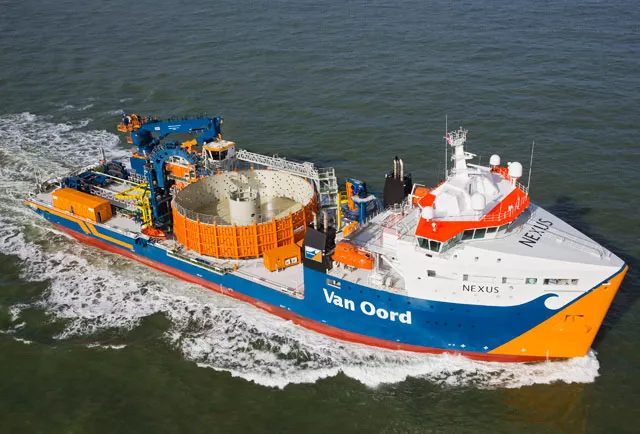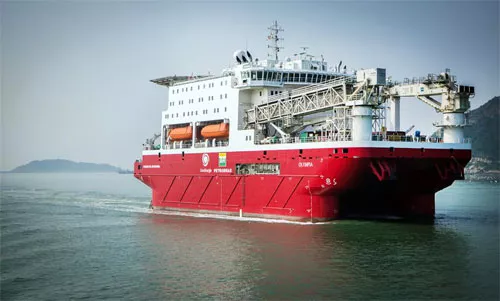Vessel types

Fast crew supplier
Fast crew supplier is capable of continuously sailing at speeds of up to 40 knots to enable short transit times. Two motion control systems and a luxury interior that can accommodate up to 200 persons ensure a highly comfortable commute. A number of marine access solutions can be selected to meet your specific needs. Together with the dynamic positioning system, this enables safe transfers in conditions up to 3.0 m significant wave height.

Platform supply vessel
A platform supply vessel (PSV) is a ship specially designed to supply offshore oil and gas platforms and other offshore installations.
The primary function for most of these vessels is logistic support and transportation of goods, tools, equipment, and personnel to and from their destination.
Anchor Handling Tug Supply (AHTS)
Anchor Handling Tug Supply (AHTS) vessels are mainly built to handle anchors for oil rigs, tow them to location, and use them to secure the rigs in place.
As they fitted with winches for towing and anchor handling, having an open stern to allow the decking of anchors, and having more power to increase the bollard pull.
Also AHTS are used as multipurpose work boats in the oil and gas offshore field. They can perform towing operations, rig moves, execute general supply duties by carrying dry and liquid cargo such as cement, mud, fresh water, fuel oil, etc for the offshore installations as need be.
In addition to towing and tugging oil rigs, another major feature of such anchor handling vessels is that they also act as rescue vessels for other ships in times of some emergency.

Light Construction Vessel
Offshore construction vessels (OSV) are large and technologically advanced vessels used for deep sea and subsea constructions.
They typically equipped with lifting, positioning and pile-driving capabilities.
OSVs usually include Dynamic Positioning systems , cranes and ROVs (Remotely Operated Vehicles) that allow operations to be conducted in the harshest weather conditions.

Survey Vessel
A survey vessel is any type of ship or boat that is used for underwater surveys, usually to collect data for mapping or planning underwater construction or mineral extraction.
The task of survey:
- Hydrography, the measurement and description of the physical features of oceans and other natural bodies of water, and the prediction of their change over time, for the primary purpose of safety of navigation and in support of other activities associated with those bodies of water,
- General oceanography, the scientific study of the oceans,
- Mapping of marine habitats as part of the process of assessing the state of the ecology,
- Maritime archaeology, the study of human interaction with the sea, lakes and rivers through the study of associated physical remains,
- Planning of marine salvage, the process of recovering a ship and its cargo after a shipwreck or other maritime casualty.

Dive Support Vessel
A diving support vessel is a ship that is used as a floating base for professional diving projects. Basic requirements are the ability to keep station accurately and reliably throughout a diving operation, often in close proximity to drilling or production platforms, for positioning to degrade slowly enough in deteriorating conditions to recover divers without excessive risk, and to carry the necessary support equipment for the mode of diving to be used.

Pipe Lay Vessel
A pipelaying ship is a maritime vessel used in the construction of subsea infrastructure. It serves to connect oil production platforms with refineries on shore.
These vessels are capable of laying pipe on the ocean floor.
Lay methods consist of J-lay and S-lay and can be reel-lay or welded length by length. Pipelaying ships make use of dynamic positioning systems or anchor spreads to maintain the correct position and speed while laying pipe. Recent advances have been made, with pipe being laid in water depths of more than 2,500 metres (8,200 ft).

Cable Lay Vessel
A cable layer or cable ship is a deep-sea vessel designed and used to lay underwater cables for telecommunications, electric power transmission, military, or other purposes. Cable ships are distinguished by large cable sheaves[1] for guiding cable over bow or stern or both.

Rock Dumping vessel
Rock dumping vessels transport and dump rocks of various sizes for offshore and coastal protection applications. The dumping can be done with a large crane, but also through the concepts of side stone dumping vessels and flexible fallpipe vessels.
Side stone dumping vessels A Side Stone Installation Vessel (SSIV) / Side Stone Dumping Vessel (SSDV) is used for rock protection on offshore structures such as pipelines in shallow areas and for underwater rock berm construction. The rocks on board are pushed over its side. Some SSIV’s are equipped with an inclined fall pipe for rock installation underneath platforms and fixed structures.
Flexible fallpipe vessel (FFV) Flexible fallpipe vessels are used in deep water, bringing the large amounts of rock in their holds. Typically fallpipe vessels are used to install the rock in water depths up to 2000 meters. The rocks are dumped through a long and flexible fallpipe and a Remotely Operated Vehicle (ROV) makes sure the accurate dumping of the rocks.

Wind Turbine Installation Vessel
A wind turbine installation vessel (WTIV) is a vessel specifically designed for the installation of offshore wind turbines.
Most are self-elevating jackup rigs. To enable quick relocation in the wind farm it is self-propelled. It also has a slender ship shaped hull to achieve a quick turnaround time with the vessel carrying several foundations or wind turbines each time.Azimuth thrusters are used to position the vessel during jack-up operations. Some vessels use the thrusters in dynamic positioning (without jacking up) to keep the vibrating pile driver steady when installing foundations.

Drillship
A drillship is a merchant vessel designed for use in exploratory offshore drilling of new oil and gas wells or for scientific drilling purposes. In recent years the vessels have been used in deepwater and ultra-deepwater applications, equipped with the latest and most advanced dynamic positioning systems.
There are different types of offshore drilling units such as the oil platform, jackup rig, submersible drilling rig, semi-submersible platform and of course drillships.

Floating Production Storage and Offloading (FPSO)
A floating production storage and offloading (FPSO) unit is a floating vessel used by the offshore oil and gas industry for the production and processing of hydrocarbons, and for the storage of oil. An FPSO vessel is designed to receive hydrocarbons produced by itself or from nearby platforms or subsea template, process them, and store oil until it can be offloaded onto a tanker or, less frequently, transported through a pipeline. FPSOs are preferred in frontier offshore regions as they are easy to install, and do not require a local pipeline infrastructure to export oil. FPSOs can be a conversion of an oil tanker (like the Seawise Giant) or can be a vessel built specially for the application. A vessel used only to store oil (without processing it) is referred to as a floating storage and offloading (FSO) vessel.

Crane Vessel
A crane vessel, crane ship, crane barge, or floating crane is a ship with a crane specialized in lifting heavy loads, typically exceeding 1,500 t (1,500 long tons; 1,700 short tons) for modern ships. The largest crane vessels are used for offshore construction.The cranes are fitted to conventional monohulls and barges, but the largest crane vessels are often catamaran or semi-submersible types which provide enhanced stability and reduced platform motion. Many crane vessels are fitted with one or more rotating cranes. Some of the largest crane vessels use fixed sheerlegs instead; in these designs, the crane is cannot rotate relative to the ship, and the vessel must be manoeuvered to place loads. Other vessels use large gantry cranes and straddle the load.

Offshore accommodation vessel
An offshore accommodation vessel (also known as a floating hotel or floatel) is mainly used to accommodate personnel at sea during set up or maintenance of offshore structures / wind farms (owfs). Hotel ships moor or drift in direct proximity to the construction site to minimise transit time to the offshore structures and maximise the personnel’s working time. Separate landing platforms that are usually located midship or aft allow fitters to board the crew transfer vessels (ctvs) that take them to the offshore structures. A helicopter deck is also available for exchanging people and spare parts on the floating hotel. Moreover, an offshore accommodation vessel frequently serves as a construction office or control centre at sea with various communication and conference rooms. Along with a large number of cabins, many floating hotels also provide sufficient storage for offshore spare parts and workshops for various types of repair work.









